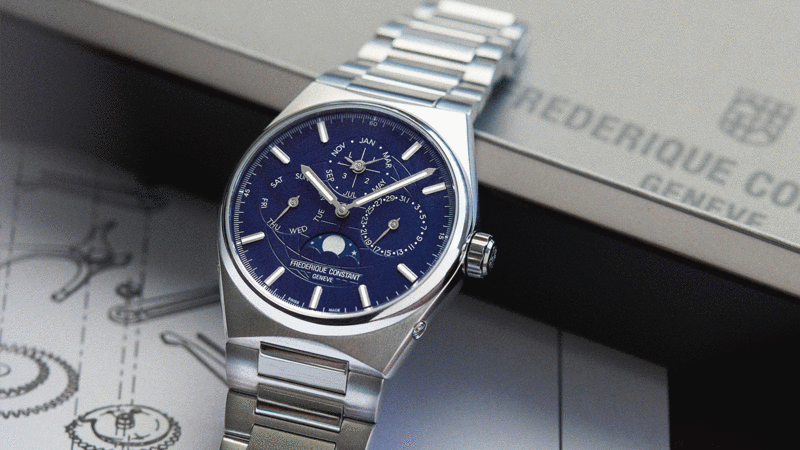THE JOURNAL

Ask a seasoned horophile to name two things that can make a high-end watch desirable and there’s a good chance they’ll answer “Swiss made” and “in-house movement”. It’s a combination that invariably spells “quality”, but it often comes with a price tag that can be off-puttingly high to a new collector – unless, that is, the name on the dial happens to be Frederique Constant.
The Geneva-based brand was founded in 1988 by Dutch couple Mr Peter Stas and Ms Aletta Stas-Bax with the aim of creating watches that were every bit as well-made, accurate, dependable and nicely finished as those that only the very wealthy could usually afford – but which were also realistically priced.
The plan was ambitious in anyone’s book, but now Frederique Constant stands virtually alone as a Swiss maker that conceives, develops and assembles its own movements and puts them into watches the likes of which other dial names might sell for two, three, even five times the price.

One man who has been instrumental in Frederique Constant achieving its goal is technical director Mr Pim Koeslag, a master watchmaker who joined the firm almost 19 years ago and who has been responsible for its impressive line-up of no fewer than 30 in-house movements (so far). At the age of 18, Netherlands-born Koeslag enrolled at watchmaking school in Amsterdam where he was awarded the accolade of “best student” of his intake – the prize for which was an internship with Patek Philippe.
The revered firm subsequently offered him a full-time job, something that would be seen as a dream ticket for most watchmakers. But during a field trip to the workshops of several Geneva-based brands midway through his course, Koeslag had visited Frederique Constant and met Peter Stas.
“My teacher thought it would be good for me to meet Peter and Aletta because, like me, they were Dutch,” he recalls. “I was standing there with my classmates when Peter suddenly said to us: ‘Would anyone here like to help me to develop watch movements?’ I was the only one who said yes and that, although I didn’t know how to do it, I was willing to give it a try.”

Even before he had completed his course Koeslag began working on the inaugural Frederique Constant Manufacture movement, the FC-910 – and was employed full-time by the firm in 2002, just three weeks after graduating. He went on to play a key role in the introduction and development of Frederique Constant’s flagship “Manufacture Collection” that exclusively uses in-house movements, and many of his inventions have been patented – including unique interpretations of haute horology mechanisms such as perpetual calendars and tourbillons.
But how much does the average watch buyer really care about whether the movement of a mechanical watch was created by the manufacture, or bought-in from a third-party supplier?
“I think it’s important to teach people about the significance of a Manufacture movement because, by buying a Frederique Constant, they are getting into the game of watches – and they soon see the difference between components that are supplied from outside and those that are made in-house to our own standards and subjected to our own quality control,” explains Koeslag.

Watch enthusiasts who are new to the brand are often astounded by the affordability of even its most complicated piece. The Highlife Perpetual Calendar Manufacture, for example (Koeslag’s personal favourite) retails for £8,595 – around a third of the cost of similar watches from the historic brands – while the Classics Worldtimer Manufacture (FC-718), the most popular model in the Manufacture range, starts at just £3,230.
“When we began to develop one of our high-end watches we set-out three criteria,” says Koeslag. “It had to be manufactured in-house; it had to be good-looking; it had to be affordable.
“The only way to achieve the latter in a watch as complex as a perpetual calendar is to reduce the time required to machine and assemble the movement – so we worked very hard to perfect the industrialisation of the calibre so that most of our watchmakers could assemble it, and the watch would run accurately without needing adjustment.” Koeslag says that once someone has discovered Frederique Constant, they often begin to buy multiple examples of the brand’s watches “because they realise the quality and value for money is incomparable”.

Frederique Constant even creates one-off commissions for its most dedicated enthusiasts, and the brand has been a regular contributor to the biennial Only Watch charity auction where its unique pieces have fetched significant sums. Last year, for example, it donated a one-off version of its Highlife Monolithic Manufacture watch containing the brand’s 30th Manufacture calibre, it’s most technically advanced to date.
“The Monolithic Manufacture movement is revolutionary,” explains Koeslag. “It features an oscillator that takes the form of a single, silicon disc that turns back and forth at an angle of six degrees – meaning it goes 10 times faster than a conventional escapement. Instead of 26 components, there is just one component with two regulation weights, and the speed at which it operates means greater stability. “It’s a complete re-interpretation of a system that has otherwise remained the same for 300 years.” Which is pretty darned impressive for a maker that’s only been around for the last 34.
“And we’ve got a lot more ideas to come,” promises Koeslag. “Inventing mechanisms like that and doing special projects which allow us to go a little bit crazy – it’s why I became a watchmaker.”